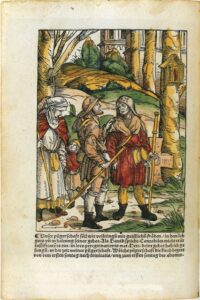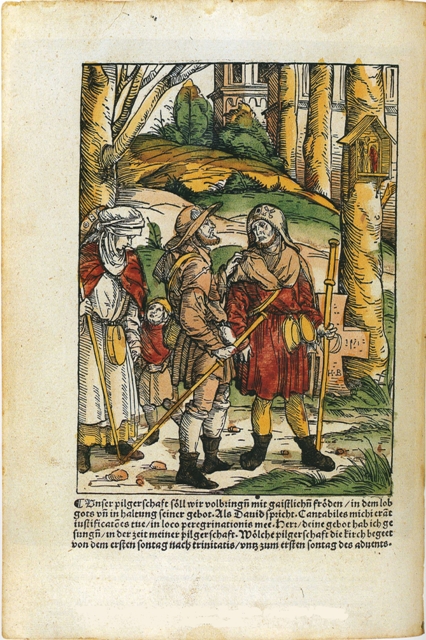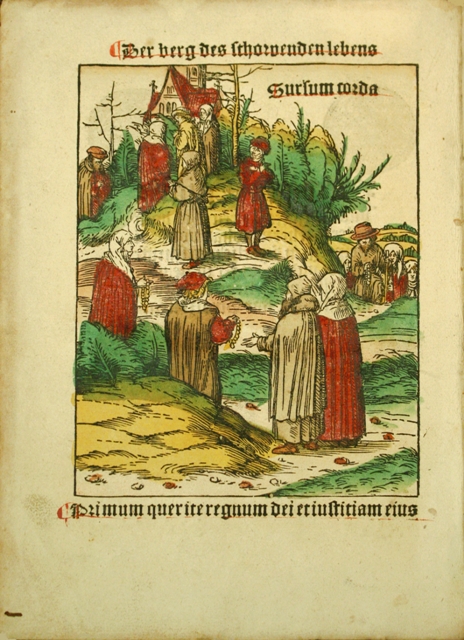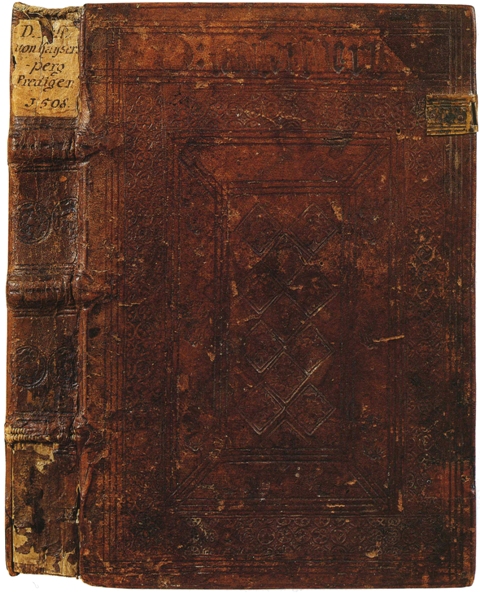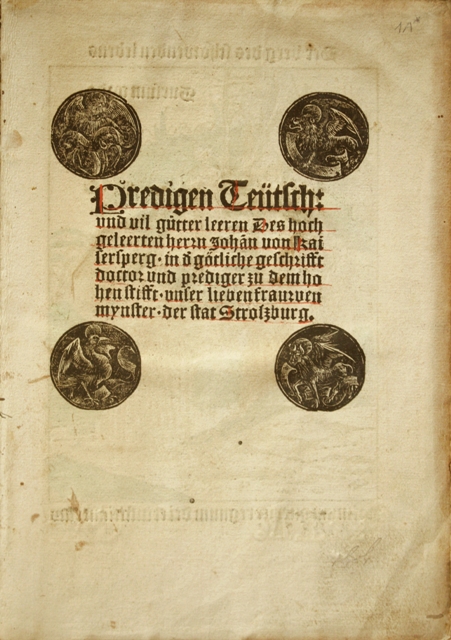Augsburg, Hans Otmar, 1508.
Folio [280 x 195 mm] of 156 ll. Small wormtrack in the white margin of about thirty ll. Full brown blind-stamped calf over wooden boards, a few traces of wear on the spine. Contemporary binding.
First edition of the sermons of Strasbourg of Geyler von Kaiserberg, illustrated in first state by Hans Burgkmair. VD 16, G 790 ; Burgkmair-Ausst. Augsb. 1963, Nrn. 30-32 u. Abb. 35/36 ; Burkhard 88 ; Dacheux 36 ; Dodgson II, 61, 6 ; Goed. I, 399, 9 ; Muther 857 ; Panzer, DA 603 ; Proctor/Isaac 10671.
Jean Geyler von Kaiserberg was raised by his grand-father, in Alsace, studied literature in Fribourg in Breisgau and theology in Basel, where he became a doctor in 1475. Soon he distinguished himself in the sacred eloquence in Fribourg and Wurtsburg, and carried out for 30 years the role of preacher in the cathedral of Strasbourg. His bold and sharp Sermons attracted so many people, that the chapel of St Laurent, where he preached, became too small, and, in 1481, after Hammerer’s drawings, was erected the beautiful pulpit decorated with little diabolic figures that can still be seen in the cathedral.
The edition is illustrated with 4 woodcuts in medallion on the title-page symbolizing the 4 evangelists and with 3 full-page woodcuts by Hans Burgkmair sumptuously hand-colored at the time that represent the first significant work of the artist.
Hans Burgkmair (1473-1553) was a painter and a drawer. Student of Martin Schongauer, he left in his 17th year, as Dürer, to Italy, where he will return later, probably between 1506 and 1508. Until around 1510, he remained pretty faithful to the old Germanic manner, which his father explained to him, and it was only from this date that he moderated the vigorous but still dry rwad of his technique with the harmony of the Italian school that Dürer had introduced so often in his work. Burgkmair paid particular attention to picture scenes of everyday life, and this orientation of his brushwork also increased his aptitudes to realism. His portraits are very alive, full of vigor and vividness.
“His work as an illustrator is considerable for the works of the preacher Gailer de Kaiserberg (1445-1510), then in 1508 he gives a drawing from which Jost de Negker will execute the monochrome picturing the emperor Maximilian on horse and in armor.
From 1509 to 1512, he engraves 92 woodcuts for Maximilian’s genealogy for whom he works almost exclusively from now on. He illustrates mythological-historical novels of the emperor, including the ‘Theuerdank’ of 1527, he collaborates to the ‘Triumph’s cortege’, edited in 1526 by the archduke Ferdinand and to the emperor’s ‘Book of Prayers’, kept in Besançon’s Library. Around 1519-1520, he produced several suites of drawings for the engraving; the one of the ‘Heroes’, the ones of the ‘Heroines’, Christians, Jews and Pagans, the ones of the ‘Love Madness’, where we find Samson, David, Solomon, Aristotle. In 1523, he illustrated ‘The Old Testament’, translated by Martin Luther.” Bénézit.
A precious wide-margined copy, preserved in its original blind-stamped brown calf binding over wooden boards, without restoration.
